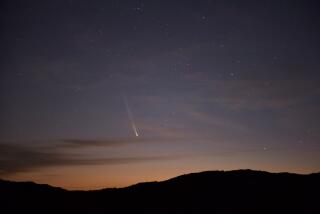Remnants From Comet Detected Near Jupiter : Astronomy: Discovery resembles “17 pearls on a string.” Number of pieces overwhelms previous sightings.
- Share via
Astronomers in the western United States have discovered a train of at least 17 very bright objects near Jupiter that they believe are pieces of a single mountain-size comet broken apart last summer in a close encounter with the giant planet.
“My jaw dropped open when I saw it go by on the screen,” said Jim Scotti of the University of Arizona’s Spacewatch program.
Comets--fuzzy-looking balls of dirty ice that are fragile at the core--have been known to split in the past, astronomers noted, but never before could observers count more than about five pieces. They said the new find resembles “pearls on a string,” except that it has a wispy tail. Comets may sprout spectacular tails of gas and dust when their elliptical orbits bring them close to the sun’s radiation and winds of charged particles.
The new discovery is dubbed Comet Shoemaker-Levy, after the team of U.S. Geological Survey scientists that spotted it. They did so, they said, despite the fact that they were economizing by using damaged film and fighting rain, fog and snow atop California’s Mt. Palomar last week.
As Carolyn Shoemaker scanned the film late Thursday, she called out, “I’ve got a squashed comet!” her husband Eugene recalled Monday. The two astronomers, with colleague David Levy, were using an 18-inch telescope.
On Friday, the weather was better for Scotti, observing from Arizona’s Kitt Peak. Where the Shoemaker team had seen five pieces, Scotti counted 11.
Then Jane Luu of UC Berkeley and David Jewitt of the University of Hawaii weighed in. With superb observing conditions atop the extinct volcano Mauna Kea, and using an 88-inch telescope, they managed to resolve 17 separate “sub-nuclei” of ice they said were “strung out like pearls on a string.”
Brian Marsden of the Harvard-Smithsonian Center for Astrophysics in Cambridge, Mass., said the comet caravan is “extraordinarily bright considering its distance” about 470 million miles from Earth, probably because of the glare of its freshly exposed icy surfaces. He estimated that the comet’s closest approach to Jupiter, whose diameter is 11 times that of Earth, would have been about July.
Passing within about 4 million miles of Jupiter, astronomers said, would have subjected the comet to the violent “tidal forces”--conflicting tugs--of the gaseous planet’s powerful gravity. This is deemed the likely cause of the comet’s breakup.
Marsden said that a primary reason there are so many pieces still close together is the short time--a few months--between the breakup and the sighting.
The comet’s identity before it shattered is unknown. But from now on, Shoemaker said, “it will be one of the best observed comets ever,” if it stays bright enough.
“We rarely get to see the long-term behavior of freshly broken-up cometary surface,” he added. “This is really a whole new experiment.”
As the “pearls” spread apart gradually, he said, scientists will study their motions to reconstruct their journey back to the cataclysm at Jupiter.
Also Monday, Luu and Jewitt reported another discovery, this one a “very faint object” orbiting probably beyond Pluto, at least 38 and possibly 56 times as far from the sun as Earth. It is the second object ever detected that could have come from a hypothetical comet “warehouse” known as the Kuiper Belt, believed to exist beyond Neptune.
More to Read
Sign up for Essential California
The most important California stories and recommendations in your inbox every morning.
You may occasionally receive promotional content from the Los Angeles Times.













